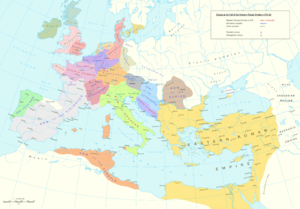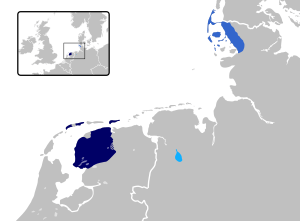Frisians facts for kids
| Total population | |
|---|---|
| c. 530,000 | |
| Regions with significant populations | |
| Friesland | 350,000 |
| Netherlands (excluding Friesland) | 120,000 |
| Germany | 60,000 |
| Canada | 4,590 residents of Canada reported having Frisian ancestry in the 2016 Canadian Census. |
| United States | 2,145 (ancestry estimate) |
| Languages | |
| Frisian languages Low Saxon (Friso-Saxon dialects) Dutch (West Frisian Dutch and Stadsfries) German (Missingsch) Danish (Sønderjysk and Southern Schleswig Danish) |
|
| Religion | |
| Protestant majority (Calvinists and Lutherans) Roman Catholic minority |
|
The Frisians are a group of people who have lived for a very long time in the coastal areas of the Netherlands, north-western Germany, and southern Denmark. Long ago, during the Early Middle Ages, they also lived in parts of Belgium. They live in a region called Frisia. Most Frisians are found in the Dutch provinces of Friesland and Groningen. In Germany, they live in East Frisia and North Frisia. North Frisia was actually part of Denmark until 1864.
People have different ideas about where the name "Frisians" comes from. It probably comes from the Roman names Frisii or Fresones. These names were used by the Romans for a Germanic tribe that lived in the same area a long time ago. That old tribe disappeared around the 5th century, before the modern Frisians appeared. One idea is that the name comes from a Latin word, fresare, which means 'to mill' or 'to cut'. This might refer to how the early Frisians 'cut the land' by digging ditches and building dykes to manage the wet marshlands where they lived. Another idea is that the name comes from a word meaning 'to braid', perhaps referring to braided hair.
More than 500,000 people speak the Frisian languages. West Frisian is an official language in the Netherlands, especially in Friesland. In Germany, North Frisian and Saterland Frisian are recognized as important regional languages.
Contents
History of the Frisians
Before the modern Frisians, there was an ancient tribe called the Frisii. They first appeared in Roman history around 12 BC during a war led by Drusus. They were sometimes mentioned in Roman war stories against Germanic tribes, including the Revolt of the Batavi around 70 AD. Some Frisian soldiers were even hired as cavalry to help the Romans invade Britain.
After 70 AD, they weren't mentioned again until about 296 AD. At that time, some were moved into Roman lands as laeti, which were like serfs (people tied to the land). Special pottery found from the 4th century shows that some Frisii were resettled in Flanders and Kent, likely forced by the Romans.
From the 3rd to the 5th centuries, the Frisian lands faced big floods from the sea. The weather also became colder and wetter. This made much of the land impossible to live on. The number of people living there dropped a lot, and the coastal areas were mostly empty for about 200 years.
When conditions got better, new settlers arrived in Frisia. Most of these new people were Angles and Saxons. These new groups eventually became known as 'Frisians'. They are the main ancestors of the Frisians we know today.
By the end of the 6th century, Frisian territory had grown westward along the North Sea coast. In the 7th century, it stretched south to Dorestad. This large area is sometimes called Frisia Magna (Great Frisia). Early Frisia was led by a powerful king. The first mention of a 'Frisian King' is from 678 AD.
In the early 8th century, most Frisians worshipped Germanic gods like Thor and Odin, except near Utrecht. Later, Frisian leaders started fighting more with the Franks from the south. This led to a series of wars. The Frankish Empire eventually took control of Frisia in 734 AD. These wars also helped Christian missionaries, like Saint Willibrord, convert many Frisians to Christianity.
After the death of Charlemagne, the Frisian lands were supposed to be controlled by the Count of Holland. However, the counts, starting with Count Arnulf in 993, couldn't really control Frisia. This led to a special time called the 'Frisian freedom'. During this period, there was no feudalism (a system where land is held in exchange for service) or serfdom (being tied to the land). The Frisian lands only had loyalty to the Holy Roman Emperor.
However, in the 13th century, the counts of Holland became much stronger. Starting in 1272, they tried to take back control of the Frisian lands. This led to a series of wars that lasted a long time, with many breaks. The wars ended in 1422. Holland conquered Western Frisia, and a stronger noble class was established in Central and Eastern Frisia.
In 1524, Frisia became part of the Seventeen Provinces. In 1568, it joined the Dutch revolt against Philip II, the king of Spain. Central Frisia has been part of the Netherlands ever since. The eastern parts of Frisia later became part of different German states and Denmark.
Frisians Moving to England and Scotland
It's hard to know exact numbers, but many Frisians were part of the groups who settled in what is now England. They arrived alongside the Angles, Saxons, and Jutes starting around the 5th century. Frisians first came to the coast of Kent.
Frisians mainly settled in areas like modern-day Kent, East Anglia, the East Midlands, North East England, and Yorkshire. You can find evidence of their settlement in place names that come from Frisian, such as Frizinghall in Bradford and Frieston in Lincolnshire.
People have noticed that the way people speak in Great Yarmouth is similar to how people speak in Friesland. This is because of trade between these areas during the Middle Ages. Frisians are also known to have founded the Freston area of Ipswich.
In Scotland, historians have found that groups of Angles and Frisians settled as far north as the River Forth. These areas of Scotland were historically part of Northumbria.
Frisians in Denmark
The first signs of Frisians in modern-day Denmark are from the 8th century. Frisian traders and craftspeople settled in Ribe. Later, in the Middle Ages, Frisian farmers settled around Tøndermarsken, west of Tønder. We know this because of the dwelling mounds, or terps (called værfter there), in the area. These mounds were built using the same methods as those along the Wadden Sea further south.
People from the south also settled in Misthusum in the Ballum marshes near Skærbæk during the 12th or 13th century. Old documents from around 1400 show that some of them were considered "Hollanders."
Today, Frisian culture in Denmark has largely blended in. Most people of Frisian background do not think of themselves as Frisian. Very few people speak the Frisian language as their first language in Denmark. However, it was traditionally spoken in some small villages near the border with Germany. One guess is that there are between 2,000 and 5,000 Frisians in Denmark, but this number might be too high.
Frisian Languages
The Anglo-Saxons of England and the early Frisians came from similar groups of tribes. Because of this, their languages were very much alike. Together, they form the Anglo-Frisian language family. Old Frisian is the language most closely related to Old English. The modern Frisian languages are still the closest relatives to today's English, even though modern Frisian and English speakers can't easily understand each other.
The Frisian language group is split into three languages. Speakers of one Frisian language usually cannot understand the other two:
- West Frisian: This is spoken in the Dutch province of Friesland.
- Saterland Frisian: This is spoken in the German town of Saterland, just south of East Frisia.
- North Frisian: This is spoken in the German region of North Frisia on the west coast of Jutland.
Of these three languages, both Saterland Frisian (with about 2,000 speakers) and North Frisian (with about 10,000 speakers) are in danger of disappearing. West Frisian is spoken by around 350,000 native speakers in Friesland. If you include speakers in the nearby Groningen province, the number goes up to 470,000. West Frisian is not listed as threatened, but some studies suggest it might be.
Frisian Identity
Today, Frisians are divided into three main groups: North, East, and West Frisians. This happened because Frisia kept losing land during the Middle Ages. Generally, West Frisians do not see themselves as part of a larger Frisian group. A survey from 1970 showed that they feel more connected to the Dutch people than to East or North Frisians.
See also
 In Spanish: Frisones para niños
In Spanish: Frisones para niños
- Anglo-Frisian languages
- Frisian Americans
- Frisian church in Rome
- Frisian Islands
- Frisian languages
- East Frisian (Saterland Frisian)
- North Frisian
- West Frisian
- Friso-Saxon dialects
- East Frisian Low Saxon
- Gronings
- Stellingwarfs
- Ingvaeonic languages
- List of Frisians
- List of Germanic tribes




